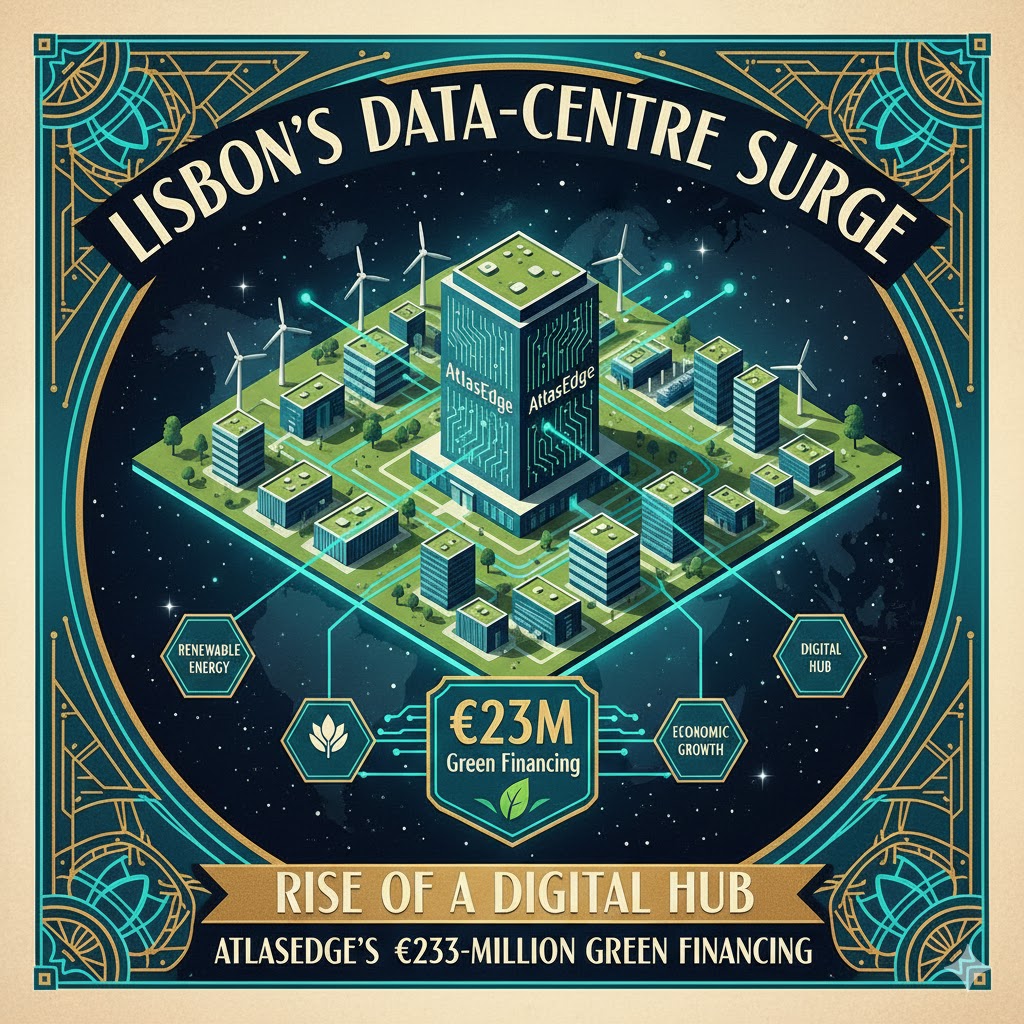A new era for Europe’s digital infrastructure
For more than a decade the largest European data‑centre markets have been concentrated in FLAP‑D – Frankfurt, London, Amsterdam, Paris and Dublin. Massive hyperscale campuses in those cities serve cloud providers and hyperscalers, but rapid growth in AI inference, streaming media, online gaming and latency‑sensitive applications is pushing demand beyond traditional hubs. These workloads need proximity to end‑users, access to renewable power and resilience against regulatory bottlenecks. As a result, investment capital is flowing into second‑tier markets such as Lisbon, Barcelona and Stuttgart, ushering in a wave of smaller, greener, more distributed facilities.
Lisbon has recently emerged as one of Europe’s most promising digital gateways. The Portuguese capital sits at the intersection of multiple submarine cable routes connecting Europe, Africa, the Middle East and the Americas. According to a March 2025 analysis by Cushman & Wakefield, the data‑centre market in Portugal is still small (about 15 MW of operational capacity) but is growing quickly, with a 9 % increase in operational capacity and 16 % growth in planned or under‑construction capacity across the EMEA regiontheportugalnews.com. Lisbon’s success is underpinned by abundant renewable energy – more than 70 % of Portugal’s electricity comes from sustainable sourcestheportugalnews.com – and by its proximity to new subsea cables such as Google’s Nuvem cable and the 2Africa systemtheportugalnews.com.
The €253‑million green financing package
On 28 October 2025, AtlasEdge, a European edge data‑centre provider backed by Liberty Global and DigitalBridge, announced that it had secured €253 million in green financing to expand its Lisbon campusatlasedge.com. The financing is structured as a seven‑year senior secured Term Bond divided into two tranches:
| Tranche | Purpose | Amount |
|---|---|---|
| Facility A (LIS001) | Finance the construction of the first building (LIS001) | €63 millionatlasedge.com |
| Facility B (LIS002) | Finance the second building (LIS002) | €190 millionatlasedge.com |
The financing is sustainability‑linked: it is tied to energy‑efficiency metrics and the requirement that the campus use 100 % renewable electricityatlasedge.com. Banco Santander and ING acted as bookrunners, while ING served as the sole sustainability coordinatoratlasedge.com. This structure reflects a broader trend in digital infrastructure finance. In 2023 AtlasEdge secured a €725 million sustainable‑linked credit facility with ING and other banks; that package included €525 million in committed debt and a €200 million accordion and incorporated sustainability targets focusing on energy efficiency and renewable energy usagedatacenterdynamics.com. The latest Lisbon deal shows that investors now require rigorous environmental criteria even in growth‑stage facilities.
Building a green campus: LIS001, LIS002 and LIS003
The Lisbon campus is located in Carnaxide, about 10 km from the Carcavelos submarine cable landing station. AtlasEdge broke ground on the campus in April 2024datacenterdynamics.com and is planning three phases that will deliver roughly 30 MW of total capacityatlasedge.com. The first phase, LIS001, has already launched and was designed for top‑tier customers; services are scheduled to go live by the end of 2025atlasedge.com. The second phase, LIS002, is in master planning with a ready‑for‑service date in 2028atlasedge.com. AtlasEdge has also acquired a 10,000‑square‑metre plot contiguous with LIS002 for LIS003, bringing the site’s future capacity to about 30 MWatlasedge.com.
The LIS001 building offers more than 3,162 m² of technical space and is supplied by a 10 MVA power feed. Baxtel reports that it has carrier‑neutral connectivity with diverse cable routing, a statistic UPS system in an N+N configuration, and N+N generators for the entire buildingbaxtel.com. LIS001’s location in Carnaxide is strategic; it is close to the city centre yet only 14 km from Lisbon’s main airport and within two kilometres of other data‑centre and telecom facilitiesbaxtel.com. The upcoming LIS002 facility, scheduled for 2028, will adjoin LIS001 on the same campus and is expected to double capacitybaxtel.com.
Why Lisbon? A convergence of connectivity and sustainability
Investors are betting on Lisbon because the Iberian Peninsula has become a critical gateway between continents. Cushman & Wakefield’s study emphasises that Lisbon’s data‑centre sector is still in its infancy but attracting significant investment, citing AtlasEdge’s development alongside a 180 MW campus planned by Merlin Properties and the 1.2 GW Start Campus project in Sinestheportugalnews.com. The analysis notes that Lisbon’s proximity to emerging submarine cables, including Google’s Nuvem cable (scheduled for 2026) and the 2Africa cable, enhances the city’s role as a digital gatewaytheportugalnews.com. More than 70 % of Portugal’s electricity comes from renewable sourcestheportugalnews.com, making Lisbon especially attractive to data‑centre operators trying to meet carbon‑neutral goals.
In a statement accompanying the financing announcement, Tesh Durvasula, CEO of AtlasEdge, described the Lisbon campus as a “sustainable, strategically located campus” and said the green financing “demonstrates the momentum we’re building across the Iberian Peninsula”datacenterdynamics.com. Sicco Boomsma, managing director at ING, noted that the financing “provides the flexibility to scale the Lisbon campus” and reflects the lender’s strong appetite for data‑centre dealsdatacenterdynamics.com. The financing also underscores Portugal’s policy ambition: Lisbon benefits from land in strategic industrial areas and a strong renewable‑energy base, but the country must expand dark‑fibre coverage to fully support “digital factories of the future”theportugalnews.com.
Investment implications and the wider European context
AtlasEdge’s Lisbon deal is part of a wider European shift toward edge computing and regional hubs. By establishing smaller facilities near population centres, operators can reduce latency for cloud gaming, AI inference and industrial IoT applications. At the same time, sustainability‑linked financing is becoming standard in the industry. Investors such as ING, Banco Santander and ABN Amro have inserted environmental covenants into debt packages, recognising that data‑centre energy consumption is under increasing regulatory scrutiny. The Lisbon campus’s reliance on Portuguese renewable energy – with more than 70 % of electricity coming from renewable sourcestheportugalnews.com – helps de‑risk these investments.
The campus also positions Lisbon to capture traffic from transatlantic routes. Being less than 10 km from the Carcavelos cable landing station allows AtlasEdge to offer low‑latency links to Europe, Africa, the Middle East and the Americasatlasedge.com. As the 2Africa and Nuvem cables come online, demand for local cross‑connects and colocation will increase, and Lisbon could evolve into a southern European hub comparable to Barcelona or Marseille.
Conclusion
AtlasEdge’s €253 million green financing is more than a funding announcement; it is a signal that sustainability and regional diversification are defining Europe’s next wave of digital infrastructure. The financing supports a three‑phase campus that will deliver 30 MW of capacity, anchored in a city with abundant renewable power and growing strategic importance. For investors, the deal highlights the availability of capital for projects that marry connectivity and carbon‑conscious design. For Portugal, it underscores the country’s ambitions to become a digital gateway linking continents. And for Europe’s data‑centre sector as a whole, it marks another step in the journey beyond FLAP‑D toward a more distributed, sustainable future.









